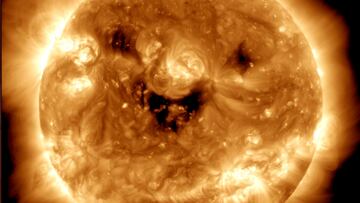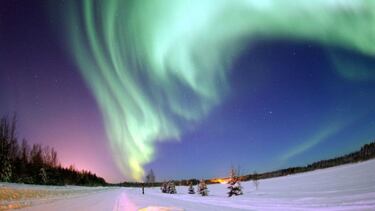What’s behind the photo of the smiling sun?
Scientists are keeping an eye on the holes seen in our star that gave rise to its grinning appearance.

On 27 October 2022, NASA shared an image in which the Sun can be seen with what looks like a cheeky, giggling smile across its burning face, under two smiling eyes. The photo has been widely shared across the internet, with people enjoying the sight of the star that gives us life apparently grinning.
However, scientists studying the sun are keeping an eye on the phenomenon that gives rise to the smiling sun image. The dark spots that can be seen in the photograph are known as coronal holes and, according to experts ”are regions where fast solar wind gushes out into space,” as explained on NASA’s Twitter account.
The image is from NASA’s Solar Dynamics Observatory, whose mission, you’ll not be surprised to learn, is to observe the changing sun in order to better understand it, its energy fluxes and also have a more accurate forecast of space ‘weather’.
Say cheese! 📸
— NASA Sun, Space & Scream 🎃 (@NASASun) October 26, 2022
Today, NASA’s Solar Dynamics Observatory caught the Sun "smiling." Seen in ultraviolet light, these dark patches on the Sun are known as coronal holes and are regions where fast solar wind gushes out into space. pic.twitter.com/hVRXaN7Z31
Solar wind is an astronomical phenomenon coming from the surface layer of the Sun, and it can be produced by two different methods: either directly from the upper layer of the solar ‘atmosphere’ or by being emitted by one of the coronal holes. In this second case, the solar wind is ejected at a higher speed.
As a general rule, the effects of this type of phenomenon do not reach the surface of the Earth, with the magnetic field of our planet protecting us from the vast majority of particles emitted by the Sun. However, it can happen that our planet suffers some consequences of a wave made up of radiation and solar wind coming from our nearest (and dearest!) star. When this happens the particles collide with the Earth’s atmosphere and we see the effects known as aurora borealis, or the northern lights. Solar storms can also occur.
The “most powerful” storms occur “very infrequently”
“The Sun is continually producing solar storms,” CSIC solar astrophysicist, Luis Bellot, tells National Geographic magazine. And, although it is true that “sometimes more powerful solar storms occur,” these do so “very infrequently.”
Therefore, although the expert highlights the need to “be prepared,” he also reminds us in the interview that “solar storms are not as dangerous as some would make us believe.”
The coronal holes that give rise to the smiling sun photo therefore are worth keeping an eye on, but scientists would not expect any significant solar storms coming from them.

What is the largest solar storm ever recorded?
Related stories
The largest solar storm ever recorded is that known as the Carrington storm, which occurred in 1859. During this event, European and North American telegraph systems suffered significant failures. There were also some changes to the seas and oceans. Most notable were the particularly bright northern lights that could be seen in regions where they are not usually seen.
If a similar event were to occur today, the damage could cause a blackout or potentially the loss of satellite coverage, but “in no case would it cause a cataclysm,” says the expert. “Currently steps have been taken to minimize all these effects.”


